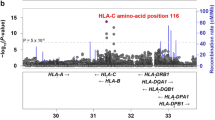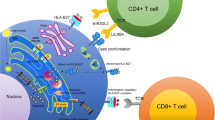Abstract
A single amino acid difference (Asp116His), having a key role in a pathogenesis pathway, distinguishes HLA-B*27:05 and HLA-B*27:09 sub-types as associated and non-associated with ankylosing spondylitis, respectively. In this study, molecular docking simulations were carried out with the aim of comprehending the differences in the binding behavior of both alleles at varying pH conditions. A library of modeled peptides was formed upon single point mutations aiming to address the effect of 20 naturally occurring amino acids at the binding core peptide positions. For both alleles, computational docking was applied using Autodock 4.2. Obtained free energies of binding (FEB) were compared within the peptide library and between the alleles at varying pH conditions. The amino acid preferences of each position were studied enlightening the role of each on binding. The preferred amino acids for each position of pVIPR were found to be harmonious with experimental studies. Our results indicate that, as the pH is lowered, the capacity of HLA-B*27:05 to bind peptides in the library is largely lost. Hydrogen bonding analysis suggests that the interaction between the main anchor positions of pVIPR and their respective binding pocket residues are affected from the pH the most, causing an overall shift in the FEB profiles.







Similar content being viewed by others
References
Abbas AK, Lichtman AH, Pillai S (2012) Cellular and molecular immunology, 7th edn. Elsevier/Saunders, Philadelphia
Hulpke S, Tampé R (2013) The MHC I loading complex: a multitasking machinery in adaptive immunity. Trends Biochem Sci 38:412–420. doi:10.1016/j.tibs.2013.06.003
Bevan MJ (1976) Cross-priming for a secondary cytotoxic response to minor H antigens with H-2 congenic cells which do not cross-react in the cytotoxic assay. J Exp Med 143:1283–1288. http://www.ncbi.nlm.nih.gov/pmc/articles/PMC2190184/
Rock KL, Gamble S, Rothstein L (1990) Presentation of exogenous antigen with class I major histocompatibility complex molecules. Science 249(4971):918–921
Heath WR, Carbone FR (2001) Cross-presentation, dendritic cells, tolerance and immunity. Annu Rev Immunol 19:47–64. doi:10.1146/annurev.immunol.19.1.47
Sigal LJ, Crotty S, Andino R, Rock KL (1999) Cytotoxic T-cell immunity to virus-infected non-haematopoietic cells requires presentation of exogenous antigen. Nature 398(6722):77–80. doi:10.1038/18038
Rock KL, Shen L (2005) Cross-presentation: underlying mechanisms and role in immune surveillance. Immunol Rev 207:166–183. doi:10.1111/j.0105-2896.2005.00301.x
Di Pucchio T, Chatterjee B, Smed-Sörensen A, Clayton S, Palazzo A, Montes M, Xue Y, Mellman I, Banchereau J, Connolly JE (2008) Direct proteasome-independent cross-presentation of viral antigen by plasmacytoid dendritic cells on major histocompatibility complex class I. Nat Immunol 9:551–557. doi:10.1038/ni.1602
Geisow MJ, Evans WH (1984) pH in the endosome. Measurements during pinocytosis and receptor-mediated endocytosis. Exp Cell Res 150(1):36–46. http://www.ncbi.nlm.nih.gov/pubmed/6198190
Rötzschke O, Lau JM, Hofstätter M, Falk K, Strominger JL (2002) A pH-sensitive histidine residue as control element for ligand release from HLA-DR molecules. Proc Natl Acad Sci USA 99:16946–16950. doi:10.1073/pnas.212643999
Deutsch C, Taylor JS, Wilson DF (1982) Regulation of intracellular pH by human peripheral blood lymphocytes as measured by 19F NMR. Proc Natl Acad Sci USA 79(24):7944–7948. http://www.ncbi.nlm.nih.gov/pubmed/6961462
Reich Z, Altman JD, Boniface JJ, Lyons DS, Kozono H, Ogg G, Morgan C, Davis MM (1997) Stability of empty and peptide-loaded class II major histocompatibility complex molecules at neutral and endosomal pH: comparison to class I proteins. Proc Natl Acad Sci USA 94(6):2495–2500. http://www.ncbi.nlm.nih.gov/pubmed/9122223
Amigorena S, Savina A (2010) Intracellular mechanisms of antigen cross presentation in dendritic cells. Curr Opin Immunol 22:109–117. doi:10.1016/j.coi.2010.01.022
Delamarre L, Pack M, Chang H, Mellman I, Trombetta ES (2005) Differential lysosomal proteolysis in antigen-presenting cells determines antigen fate. Science (New York, NY) 307:1630–1634. doi:10.1126/science.1108003
Mantegazza AR, Savina A, Vermeulen M, Pérez L, Geffner J, Hermine O, Rosenzweig SD, Faure F, Amigorena S (2008) NADPH oxidase controls phagosomal pH and antigen cross-presentation in human dendritic cells. Blood 112:4712–4722. doi:10.1182/blood-2008-01-134791
Savina A, Jancic C, Hugues S, Guermonprez P, Vargas P, Moura IC, Lennon-Duménil A-M, Seabra MC, Raposo G, Amigorena S (2006) NOX2 controls phagosomal pH to regulate antigen processing during crosspresentation by dendritic cells. Cell 126:205–218. doi:10.1016/j.cell.2006.05.035
Gromme M, Uytdehaag FG, Janssen H, Calafat J, van Binnendijk RS, Kenter MJ, Tulp A, Verwoerd D, Neefjes J (1999) Recycling MHC class I molecules and endosomal peptide loading. Proc Natl Acad Sci USA 96(18):10326–10331. http://www.ncbi.nlm.nih.gov/pmc/articles/PMC17887/
Stryhn A, Pedersen LO, Romme T, Olsen AC, Nissen MH, Thorpe CJ, Buus S (1996) pH dependence of MHC class I-restricted peptide presentation. J Immunol (Baltimore, Md: 1950) 156:4191–4197. http://www.jimmunol.org/content/156/11/4191.full.pdf
Ma W, Van den Eynde BJ (2014) Endosomal compartment: also a dock for MHC class I peptide loading. Eur J Immunol 44:650–653. doi:10.1002/eji.201444470
Wälchli S, Kumari S, Fallang L-E, Sand KMK, Yang W, Landsverk OJB, Bakke O, Olweus J, Gregers TF (2014) Invariant chain as a vehicle to load antigenic peptides on human MHC class I for cytotoxic T-cell activation. Eur J Immunol 44:774–784. doi:10.1002/eji.201343671
Duan F, Srivastava PK (2012) An invariant road to cross-presentation. Nat Immunol 13:207–208. doi:10.1038/ni.2235
Sorrentino R, Bockmann RA, Fiorillo MT (2014) HLA-B27 and antigen presentation: at the crossroads between immune defense and autoimmunity. Mol Immunol 57(1):22–27. doi:10.1016/j.molimm.2013.06.017
Bettosini F, Fiorillo MT, Magnacca A, Leone L, Torrisi MR, Sorrentino R (2005) The C terminus of the nucleoprotein of influenza A virus delivers antigens transduced by Tat to the trans-golgi network and promotes an efficient presentation through HLA class I. J Virol 79:15537–15546. doi:10.1128/JVI.79.24.15537-15546.2005
Magnacca A, Persiconi I, Nurzia E, Caristi S, Meloni F, Barnaba V, Paladini F, Raimondo D, Fiorillo MT, Sorrentino R (2012) Characterization of a proteasome and TAP-independent presentation of intracellular epitopes by HLA-B27 molecules. J Biol Chem 287:30358–30367. doi:10.1074/jbc.M112.384339
Leonhardt RM, Fiegl D, Rufer E, Karger A, Bettin B, Knittler MR (2010) Post-endoplasmic reticulum rescue of unstable MHC class I requires proprotein convertase PC7. J Immunol 184(6):2985–2998. doi:10.4049/jimmunol.0900308
Ramos M, Lopez de Castro JA (2002) HLA-B27 and the pathogenesis of spondyloarthritis. Tissue Antigens 60(3):191–205. http://www.ncbi.nlm.nih.gov/pubmed/12445302
Ziegler A, Loll B, Misselwitz R, Uchanska-Ziegler B (2009) Implications of structural and thermodynamic studies of HLA-B27 subtypes exhibiting differential association with ankylosing spondylitis. Adv Exp Med Biol 649:177–195. http://www.ncbi.nlm.nih.gov/pubmed/19731629
Uchanska-Ziegler B, Loll B, Fabian H, Hee CS, Saenger W, Ziegler A (2012) HLA class I-associated diseases with a suspected autoimmune etiology: HLA-B27 subtypes as a model system. Eur J Cell Biol 91(4):274–286. doi:10.1016/j.ejcb.2011.03.003
Brewerton DA, Hart FD, Nicholls A, Caffrey M, James DC, Sturrock RD (1973) Ankylosing spondylitis and HL-A 27. Lancet 1(7809):904–907. http://www.ncbi.nlm.nih.gov/pubmed/4123836
Ohno S, Ohguchi M, Hirose S, Matsuda H, Wakisaka A, Aizawa M (1982) Close association of HLA-Bw51 with Behcet’s disease. Arch Ophthalmol 100(9):1455–1458. http://www.ncbi.nlm.nih.gov/pubmed/6956266
Lafuente EM, Reche PA (2009) Prediction of MHC-peptide binding: a systematic and comprehensive overview. Curr Pharm Des 15(28):3209–3220. http://www.ncbi.nlm.nih.gov/pubmed/19860671
Tong JC, Tan TW, Ranganathan S (2007) Methods and protocols for prediction of immunogenic epitopes. Brief Bioinform 8(2):96–108. doi:10.1093/bib/bbl038
Liao WW, Arthur JW (2011) Predicting peptide binding to major histocompatibility complex molecules. Autoimmun Rev 10(8):469–473. doi:10.1016/j.autrev.2011.02.003
Lin HH, Ray S, Tongchusak S, Reinherz EL, Brusic V (2008) Evaluation of MHC class I peptide binding prediction servers: applications for vaccine research. BMC Immunol 9:8. doi:10.1186/1471-2172-9-8
Peters B, Bui HH, Frankild S, Nielson M, Lundegaard C, Kostem E, Basch D, Lamberth K, Harndahl M, Fleri W, Wilson SS, Sidney J, Lund O, Buus S, Sette A (2006) A community resource benchmarking predictions of peptide binding to MHC-I molecules. PLoS Comput Biol 2(6):e65. doi:10.1371/journal.pcbi.0020065
Berman H, Henrick K, Nakamura H (2003) Announcing the worldwide Protein Data Bank. Nat Struct Biol 10(12):980. doi:10.1038/Nsb1203-980
Patronov A, Dimitrov I, Flower DR, Doytchinova I (2012) Peptide binding to HLA-DP proteins at pH 5.0 and pH 7.0: a quantitative molecular docking study. BMC Struct Biol 12:20. doi:10.1186/1472-6807-12-20
Damato M, Fiorillo MT, Carcassi C, Mathieu A, Zuccarelli A, Bitti PP, Tosi R, Sorrentino R (1995) Relevance of residue-116 of Hla-B27 in determining susceptibility to ankylosing-spondylitis. Eur J Immunol 25(11):3199–3201. doi:10.1002/eji.1830251133
Khan MA (2002) Update on spondyloarthropathies. Ann Intern Med 136(12):896–907. http://www.ncbi.nlm.nih.gov/pubmed/12069564
Falk K, Rotzschke O, Stevanovic S, Jung G, Rammensee HG (1991) Allele-specific motifs revealed by sequencing of self-peptides eluted from MHC molecules. Nature 351(6324):290–296. doi:10.1038/351290a0
Pohlmann T, Bockmann RA, Grubmuller H, Uchanska-Ziegler B, Ziegler A, Alexiev U (2004) Differential peptide dynamics is linked to major histocompatibility complex polymorphism. J Biol Chem 279(27):28197–28201. doi:10.1074/jbc.C400128200
Morris GM, Huey R, Lindstrom W, Sanner MF, Belew RK, Goodsell DS, Olson AJ (2009) AutoDock4 and AutoDockTools4: automated docking with selective receptor flexibility. J Comput Chem 30(16):2785–2791. doi:10.1002/Jcc.21256
Hulsmeyer M, Fiorillo MT, Bettosini F, Sorrentino R, Saenger W, Ziegler A, Uchanska-Ziegler B (2004) Dual, HLA-B27 subtype-dependent conformation of a self-peptide. J Exp Med 199(2):271–281. doi:10.1084/jem.20031690
The PyMOL Molecular Graphics System Vrp, Schrödinger, LLC
Sondergaard CR, Olsson MHM, Rostkowski M, Jensen JH (2011) Improved treatment of ligands and coupling effects in empirical calculation and rationalization of pK(a) values. J Chem Theory Comput 7(7):2284–2295. doi:10.1021/Ct200133y
Patronov A, Dimitrov I, Flower DR, Doytchinova I (2011) Peptide binding prediction for the human class II MHC allele HLA-DP2: a molecular docking approach. BMC Struct Biol 11:32. doi:10.1186/1472-6807-11-32
Vita R, Overton JA, Greenbaum JA, Ponomarenko J, Clark JD, Cantrell JR, Wheeler DK, Gabbard JL, Hix D, Sette A, Peters B (2015) The immune epitope database (IEDB) 3.0. Nucleic Acids Res 43(Database issue):D405-412. doi:10.1093/nar/gku938
Schittenhelm RB, Sian TCCLK, Wilmann PG, Dudek NL, Purcell AW (2015) Revisiting the arthritogenic peptide theory: quantitative not qualitative changes in the peptide repertoire of HLA-B27 allotypes. Arthritis Rheumatol (Hoboken, NJ) 67:702–713. doi:10.1002/art.38963
Durrant JD, McCammon JA (2011) HBonanza: a computer algorithm for molecular-dynamics-trajectory hydrogen-bond analysis. J Mol Graph Model 31:5–9. doi:10.1016/j.jmgm.2011.07.008
McDonald IK, Thornton JM (1994) Satisfying hydrogen bonding potential in proteins. J Mol Biol 238(5):777–793. doi:10.1006/jmbi.1994.1334
Narzi D, Winkler K, Saidowsky J, Misselwitz R, Ziegler A, Bockmann RA, Alexiev U (2008) Molecular determinants of major histocompatibility complex class I complex stability—shaping antigenic features through short and long range electrostatic interactions. J Biol Chem 283(34):23093–23103. doi:10.1074/jbc.M710234200
Wereszczynski J, McCammon JA (2012) Statistical mechanics and molecular dynamics in evaluating thermodynamic properties of biomolecular recognition. Q Rev Biophys 45(1):1–25. doi:10.1017/S0033583511000096
Huey R, Morris GM, Olson AJ, Goodsell DS (2007) A semiempirical free energy force field with charge-based desolvation. J Comput Chem 28(6):1145–1152. doi:10.1002/jcc.20634
Fabian H, Huser H, Narzi D, Misselwitz R, Loll B, Ziegler A, Bockmann RA, Uchanska-Ziegler B, Naumann D (2008) HLA-B27 subtypes differentially associated with disease exhibit conformational differences in solution. J Mol Biol 376(3):798–810. doi:10.1016/j.jmb.2007.12.009
de Castro JAL (2007) HLA-B27 and the pathogenesis of spondyloarthropathies. Immunol Lett 108(1):27–33. doi:10.1016/j.imlet.2006.10.004
Fiorillo MT, Maragno M, Butler R, Dupuis ML, Sorrentino R (2000) CD8(+) T-cell autoreactivity to an HLA-B27-restricted self-epitope correlates with ankylosing spondylitis. J Clin Investig 106(1):47–53. doi:10.1172/JCI9295
Fiorillo MT, Ruckert C, Hulsmeyer M, Sorrentino R, Saenger W, Ziegler A, Uchanska-Ziegler B (2005) Allele-dependent similarity between viral and self-peptide presentation by HLA-B27 subtypes. J Biol Chem 280(4):2962–2971. doi:10.1074/jbc.M410807200
Madden DR, Gorga JC, Strominger JL, Wiley DC (1991) The structure of HLA-B27 reveals nonamer self-peptides bound in an extended conformation. Nature 353(6342):321–325. doi:10.1038/353321a0
Fukazawa T, Wang J, Huang F, Wen J, Tyan D, Williams KM, Raybourne RB, Yu DT (1994) Testing the importance of each residue in a HLA-B27-binding peptide using monoclonal antibodies. J Immunol 152(3):1190–1196. http://www.ncbi.nlm.nih.gov/pubmed/8301123
Khan MA, Ball EJ (2002) Genetic aspects of ankylosing spondylitis. Best Pract Res Clin Rheumatol 16(4):675–690
Acknowledgments
This work was supported by TUBITAK under Grant 113M293.
Author information
Authors and Affiliations
Corresponding author
Ethics declarations
Conflict of interest
No conflicting financial interests exist.
Electronic supplementary material
Below is the link to the electronic supplementary material.
Rights and permissions
About this article
Cite this article
Serçinoğlu, O., Özcan, G., Kabaş, Z.K. et al. A computational docking study on the pH dependence of peptide binding to HLA-B27 sub-types differentially associated with ankylosing spondylitis. J Comput Aided Mol Des 30, 569–581 (2016). https://doi.org/10.1007/s10822-016-9934-z
Received:
Accepted:
Published:
Issue Date:
DOI: https://doi.org/10.1007/s10822-016-9934-z




